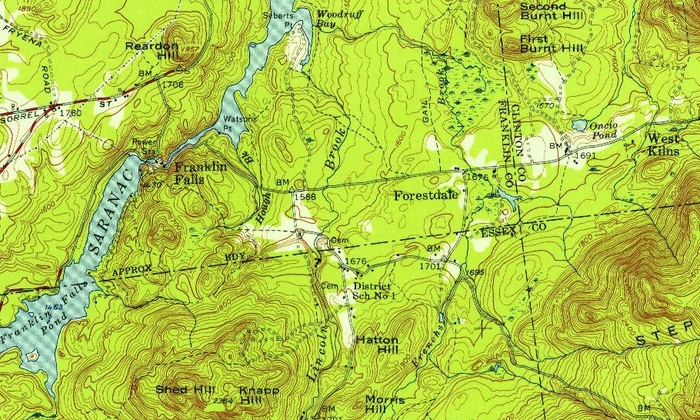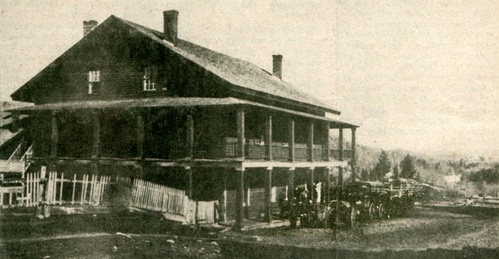 The Saranac River below Franklin falls The following has been excerpted from Nathan Brown, "The first Franklinites", Adirondack Daily Enterprise, January 17, 2009
The Saranac River below Franklin falls The following has been excerpted from Nathan Brown, "The first Franklinites", Adirondack Daily Enterprise, January 17, 2009
Fewer than 200 people lived in the town of Franklin in 1836 when the town was formed. The first permanent settlers were Isaac McLenathan and William Wells, who came from Jay in Essex County in 1827 and built a saw mill and iron forge at what is Franklin Falls today but was McLenathan Falls until 1851. The first child born in the town of Franklin, Sanford Hough, was born here in 1840. The settlement grew to include a large store, a school and a hotel. Seaver wrote that their businesses never did well, as all lumber and iron products had to be hauled 34 miles to Port Kent to be sold.
All 23 dwellings in McLenathan Falls and every other structure except a small shack was completely destroyed by a fire in 1852.
"So rapidly and fiercely did the flames spread that fowls, dogs and cattle perished in the streets, and the inhabitants themselves barely escaped with their lives," Seaver wrote. "Household goods, merchandise in the store, large quantities of lumber, and even the unsubmerged parts of wagons that had been hauled into the river were all destroyed."
 Paul Smith's hydro dam was completed in 1907, dramatically changing shape of the river and creating Franklin Fall Pond.
Paul Smith's hydro dam was completed in 1907, dramatically changing shape of the river and creating Franklin Fall Pond.
1898 USGS Lake Placid quadrant, Franklin Falls at leftPeter Comstock rebuilt the area somewhat and reopened the mills, and for 14 years a major lumbering operation under the direction of Christopher F. Norton of Plattsburgh was centered there, but they were closed again by the 20th century. There were other mills in Franklin, but never one as big. Only two were running by 1918. The hotel also reopened, changing hands a number of times, but it was never as big or bustling as it was before the fire.
The Port Kent to Hopkinton turnpike was built between 1829 and 1832. It was the town's main highway in the early days, and it was lined with rustic inns offering travelers meals and lodging for next to nothing. Today, it is county Route 26, and it isn't always plowed beyond Loon Lake in the winter.
Schools
 1953 USGS Lake Placid quadrant showing the same area as aboveThe earliest records of schooling available are from 1878, Fran Oliver wrote in "They Told Me So." In this year, the town had one school, in Vermontville across state Route 3 from where the town garage is today. Seventy-six out of the town's residents between the ages of five and 21 went to school that year; an average of 26 showed up any given day. Later, there would be at least 12 schools, although they weren't all operational at the same time.
1953 USGS Lake Placid quadrant showing the same area as aboveThe earliest records of schooling available are from 1878, Fran Oliver wrote in "They Told Me So." In this year, the town had one school, in Vermontville across state Route 3 from where the town garage is today. Seventy-six out of the town's residents between the ages of five and 21 went to school that year; an average of 26 showed up any given day. Later, there would be at least 12 schools, although they weren't all operational at the same time.
These schools only taught through primary grades; parents who wanted a high school education for their children, in the early days, had to pay to send them elsewhere and pay their room and board as well, according to Raymond Tuthill in "They Told Me So."
Betty Goff Wilson wrote abut her memories of attending primary school in a two-room schoolhouse in Vermontville in the 1950s that is the Franklin town hall today. Grades one through three were in one room, four through six in the other.
"Each day started with a recitation of the Pledge of Allegiance and the Lord's Prayer," Wilson wrote in They Told Me So. "On Monday mornings we each got a new drinking cup and had 'inspection,' which meant the teacher went up and down the aisles checking each student's fingernails, etc."
Frederick J. Seaver, Historical Sketches of Franklin County, Albany, NY: J. B. Lyon Co., 1918, p. 361
[Paul Smith's properties include] a power development plant at Franklin Falls and Union Falls generating five thousand horse power, whose transmission lines furnish light and power to Ausable Forks, Bloomingdale, Saranac Lake and adjacent country, Paul Smiths, Gabriels, Lake Clear and the St. Regis and Osgood chain of lakes, including the William Rockefeller property, with extensions planned to reach Lyon Mountain, Port Henry, Tupper Lake and the Adirondack Iron Works in Essex county.
An account of a trip through Franklin Falls in 1859 on the way to Paul Smiths was published in Charles Dickens' periodical, All The Year Round, published on September 29, 1860. The unidentified author wrote:
The people in these wilds, excepting the miners and charcoal-burners, live chiefly by logging in the winter and spring, and by hunting and farming in the fall and summer. Every man and boy carries a rifle. At Franklin Falls, on the River Saranac, we met a man who had been to drive his cow from pasture. I asked him if he always carried his rifle? He said that a few days before he had neglected to take it, as usual, and had met a fine buck, standing in the path, which seemed to dispute his right of way. Next day he took his gun, and there was the buck again. He fired, and missed him; but the deer, instead of bounding away, stood stamping and “whistling”-- i.e. snorting-- until he reloaded his rifle and shot him.
 Franklin House Adirondack Daily Enterprise, April 13, 1987 Adirondack Daily Enterprise, April 13, 1987
Franklin House Adirondack Daily Enterprise, April 13, 1987 Adirondack Daily Enterprise, April 13, 1987
Uncertain start marked advent of Franklin Falls
While Capt. Pliny Miller was building his dam and sawmill on the Saranac River in 1827, a similar operation was under way 14 miles downstream at McLenathan Falls. Miller's enterprise was destined to blossom into the Village of Saranac Lake, but the latter venture was doomed to join the ranks of the Adirondack ghost towns, a common fate for so many lumber settlements. When Isaac McLenathan and William Wells arrived on the scene, the falls had not as yet been named so McLenathan assumed the honor for himself.
So, at this early date, there was no Town of Franklin as that civil division did not take place until nine years later when, on May 20th, 1836, Franklin was formed from the large Town of Bellmont. This subdivision gave the Town of Franklin the anchor position in the extreme southeast corner of Franklin County where a tri-county junction marks the meeting of Franklin, Essex and Clinton Counties.
The partnership of McLenathan and Wells constructed both a sawmill and an iron forge going into production with high hopes for a double source of income. Their dreams were, unfortunately, short lived due to an annoying problem of transportation. Wagon loads of lumber and heavy iron had to be hauled 34 miles over rough roads to Port Kent, the nearest point of distribution since the railhead had not yet reached AuSable Forks. This seemingly insurmountable obstacle proved to be the main cause of the infant industry's failure after only a few years. Thus ended the first settlement in what was to become the Town of Franklin.
The mill site lay fallow for 15 years before two more entrepreneurs arrived to give it a try at the same location. John Fitzgerald and William McLean rebuilt the sawmill but chose to abandon the forge in 1846. One year later the pair was joined by Keese and Tomlinson from Keeseville but even this industrious foursome needed further help. In 1848 that help arrived in the person of Peter Comstock, an energetic organizer from Port Kent, who took over control of the enterprise. He immediately instigated an ambitious series of improvements and by 1851 had built a hotel, store, school, and housing for his work force. In that same year a post office was created with the new designation of Franklin Falls.
Tragedy strikes
Just when things were looking up, tragedy struck in the form of a holocaust. A forest fire had been smoldering in the nearby woods for several days with no sign of a serious threat. On the 29th of May, 1852, however, things took a change for the worse.
In a history of Franklin County, published only one year after the event, Dr. Franklin B. Hough gives us a current account of the disaster. "For several days previous, a fire had been running in the neighboring woods, and on the day of the catastrophe, the wind was blowing almost a hurricane, and scattering the fire in every direction so that all attempts to control it became unavailing. On approaching the village, which was situated in a ravine, it burst from the woods upon the settlement with such force, that every building in the place except two small ones was consumed."
Considering the speed of the flames it is a remarkable fact that no human lives were lost. All else, livestock, homes, stacks of lumber and the mill were gone. Some of the residents hastily piled their belongings on wagons which they pushed out into the river for safekeekping but upon their return after the fire, they, found that the wagons had burned to the water line so fierce were the flames. An estimate of the total loss approached a figure of $100,000 which, at that time, was an enormous sum.
Rebuilding
Undaunted, the intrepid Comstock immediately began to rebuild the place under the supervision of his newly appointed manager, George Tremble, who was also to play an important role in the area's history. On the hill above the mill, adjacent to the road leading to Bloomingdale, a new hotel was built and christened "The Franklin House."
Comstock soon moved on to greener pastures after selling out to Tremble and Tomlinson who ran all phases of the business for the next five years. In what seemed to be a perpetual turnover these partners sold out to Christopher Norton, who was known as the lumber baron of the Saranacs. Norton maintained Tremble as manager until 1868 when Tremble decided to build his own store which he operated while raising a family of five children. Highly respected throughout the district, Tremble was elected Town Supervisor for 12 years and served as postmaster for 35 years. He died at Franklin Falls in 1894 at the age of 76.
Early days
When I joined the Paul Smiths Electric Co., fifty years ago, George Tremble's son, Fred, was ensconced in the teller's cage where he collected the electric bill payments with great dignity. He was already quite elderly, and he enjoyed telling me what his early life was like as a young boy at Franklin Falls. One such story recalled a famous fishing hole which the locals called the "pork barrel." At that time French's Brook and Lincoln Brook joined forces below the road from Black Brook, a short distance downstream from the falls, and flowed as one stream into the river. A deep pool was formed where the two brooks met and here the trout gathered in great numbers. His father would send Fred down to the "pork barrel" telling him how many fish to bring back for the morrow's family breakfast. It seems that the trout were always there and willing.
Prosperity
Getting back to our main story, the Franklin House was enjoying an unprecedented prosperity which was in no way related to the mill but rather due to its propitious location. The hotel was mid-way between AuSable Forks and the fast growing resorts at St. Regis and the Saranacs. Sportsmen approaching the Adirondacks from the south and east came to AuSable by rail and then boarded a stage coach for Paul Smith's or Martin's. A plank road had been built from Black Brook to Franklin Falls with a toll gate located where the westerly route parted from the Black Brook-Silver Lake road.
Stage stop
The stages stopped at the Franklin House for meals and a change of horses and after 18 miles in a jouncing coach, the riders were hungry and thirsty. At the peak of the tourist season the hotel was serving more than 100 meals per day. Business was booming!
On the plank road, two miles east of the falls, a man by the name of French observed all of the activity passing his door. Deciding to get a piece of the action he quickly built an addition to his house and hung out his shingle.
French's was popular
French's place soon became as popular as the Franklin House probably due, in part, to a two-mile advantage it enjoyed in the east-west traffic. Sensing another opportunity, French built a wagon road from his door 4 1/2 miles up the French's Brook valley to a point on the north slope of Whiteface Mountain just two miles below the summit.
From here he cut a trail to the top and built a rough camp beside the trail to shelter those climbers who elected to stay over night and witness a sunset and sunrise from the mountain top. These simple amenities proved to be very popular with the ever increasing number of climbers and the clientele kept coming.
Rapid turnover
Over a period of 40 years, between 1852 and 1892, the ownership of the Franklin House changed hands no less than eleven times. Paul Smith married Lydia Martin there in 1859, and he became the final owner by purchasing the place in 1892. Paul had other plans in mind and he began buying up the surrounding property adjacent to the falls. By this time the mill and the little village had ceased to exist but the water power was still there. Paul recognized the possibilities of electrical generation long before most of his contemporaries, and he did not hesitate to act on his intuition. He had closed the hotel so that it could be used to house his work crew and in 1904 construction was started on a new dam and a hydro generating station. When the dam was finished in 1907, water flooded some state land and in 1908 Paul was hit with an injunction.
Final project
After four years of litigation the judge ruled in favor of Paul Smith. On August 20th, 1912 Paul was able to celebrate his 87th birthday with a visit to his new hydro plant where he watched a huge generator convert water power to electricity. He had only four months left to enjoy the success which fledgling industry promised. He entered a Montreal hospital with a kidney problem and perished there on December 15th, 1912.
The old Franklin House was torn down in 1937 leaving only one reminder of what once was the thriving settlement of Franklin Falls. Hidden by a fringe of brush is a small cemetery where, among other toppling stones, one monument records the sad story of a 16-year-old boy "killed in the mill".
While the Franklin Falls hydro plant was under construction, Paul Smith had a similar project going at Union Falls seven miles downstream. That dam was also completed in 1907 and, as the reservoir filled, the water was backed up all the way to Franklin. This newly flooded area completely inundated the point where French's Brook and Lincoln Brook once came together so that now each brook enters the river in a separate course. The once famous old "pork barrel" disappeared forever beneath the water of the Union Falls Flow.
Beers Franklin County Atlas, 1876
Franklin Business Notices.
Flack D. W , Proprietor Mineral Spring House, Franklin Falls.
Tremble Geo., Post Master And Dealer in Dry Goods, Groceries, Boots And Shoes, Franklin Falls.
Walston R. L., Farmer And Surveyor, Dist. 12. P. O. Franklin Falls.



